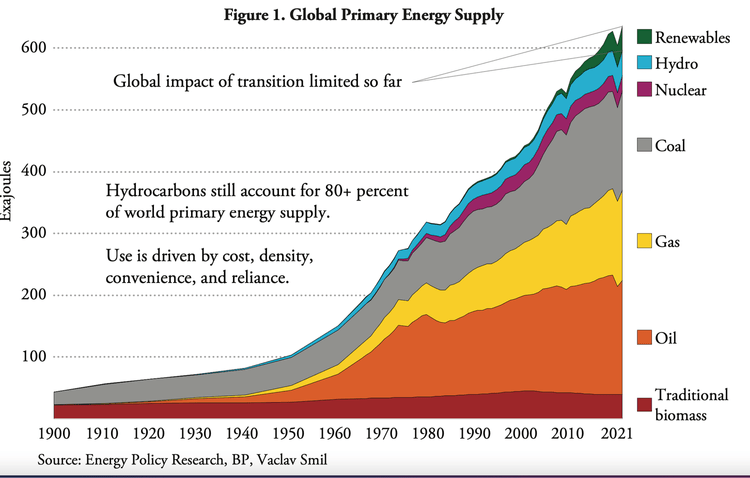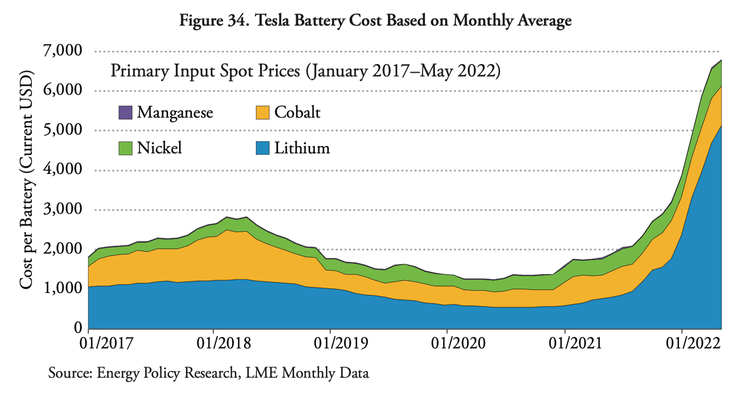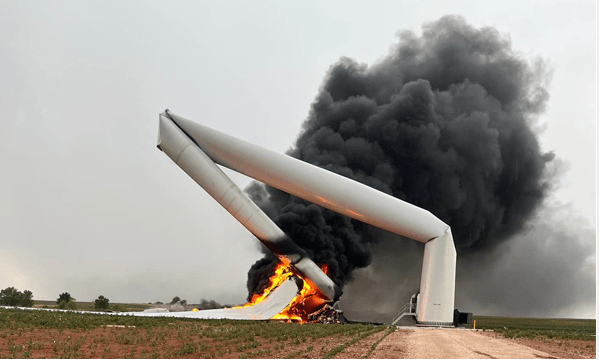The vacuous ninnies promoting the line that the world can run without hydrocarbons are always rattled by news to the contrary. As much a symptom of ideological groupthink, as evidence of the West’s woefully inadequate system of general education, the Extinction Rebellion crowd would have it that coal, oil and gas are forms of toxic evil to be expunged from the universe. As a matter of urgent and virtuous necessity.
The reality is that the reliable and affordable energy delivered by hydrocarbons is essential to modern civilisation. Moreover, there are a host of critical uses for coal, oil and gas beyond the energy they deliver.
In this thumping trifecta, three energy heavy hitters – Paul Homewood, Vaclav Smil and Francis Menton – provide a primer on why the world we live in critically depends on coal, oil and gas.
BP Energy Review 2022
Not a Lot of People Know That
Paul Homewood
27 June 2023
I’m amazed they’re surprised!
Renewables growth did not dent fossil fuel dominance in 2022, a report has revealed.
Renewable energy failed to shift the dominance of fossil fuels in 2022, a new report has shown, despite a massive growth in wind and solar capacity.
Global energy demand rose 1 percent last year, the Statistical Review of World Energy report revealed on Monday – and the 82 percent of total supply was provided by oil and gas generation.
This is despite a massive increases in renewable capacity, which grew by a whopping 266 gigawatts.
“Despite further strong growth in wind and solar in the power sector, overall global energy-related greenhouse gas emissions increased again,” said the president of the UK-based global industry body Energy Institute, Juliet Davenport.
“We are still heading in the opposite direction to that required by the Paris Agreement.”
The Annual Review used to be published by BP, but apparently, in their words, “The Statistical Review of World Energy has a new custodian: the Energy Institute (EI), the chartered professional membership body for people who work in energy”.
It is slightly concerning then that the Energy Institute is not quite the professional body that BP make out, but a lobby group for Net Zero:
Nevertheless, the spreadsheets still look the same, and we can ignore a lot of the fluff published in the EI report, as the chart below tells us all we really need to know:
https://www.energyinst.org/statistical-review/resources-and-data-downloads
In essence nothing has changed year-on-year. Although renewable energy output has risen by 13%, its share of total energy has only gone from 1.5% to 1.7% (in contrast to EuroNews’ attempts to fool readers with claims of an increase of a whopping 266 gigawatts).
The other chart of interest is CO2 emissions, which have resumed their steady rise following signs of a standstill last year, which as I noted at the time was probably Covid related. They rose 1% from 2021 to 2022, and now stand 5% higher than in 2015 when the Paris Agreement was signed:
The Modern World Can’t Exist Without These Four Ingredients. They All Require Fossil Fuels
Time
Vaclav Smil
12 May 2023
Modern societies would be impossible without mass-scale production of many man-made materials. We could have an affluent civilization that provides plenty of food, material comforts, and access to good education and health care without any microchips or personal computers: we had one until the 1970s, and we managed, until the 1990s, to expand economies, build requisite infrastructures and connect the world by jetliners without any smartphones and social media. But we could not enjoy our quality of life without the provision of many materials required to embody the myriad of our inventions.
Four materials rank highest on the scale of necessity, forming what I have called the four pillars of modern civilization: cement, steel, plastics, and ammonia are needed in larger quantities than are other essential inputs. The world now produces annually about 4.5 billion tons of cement, 1.8 billion tons of steel, nearly 400 million tons of plastics, and 180 million tons of ammonia. But it is ammonia that deserves the top position as our most important material: its synthesis is the basis of all nitrogen fertilizers, and without their applications it would be impossible to feed, at current levels, nearly half of today’s nearly 8 billion people.
The dependence is even higher in the world’s most populous country: feeding three out of five Chinese depends on the synthesis of this compound. This dependence easily justifies calling ammonia synthesis the most momentous technical advance in history: other inventions provide our comforts, convenience or wealth or prolong our lives—but without the synthesis of ammonia, we could not ensure the very survival of billions of people alive today and yet to be born.
Plastics are a large group of synthetic organic materials whose common quality is that they can be molded into desired shapes—and they are now everywhere. As I type this, the keys of my Dell laptop and a wireless mouse under my right palm are made of acrylonitrile butadiene styrene, I sit on a swivel chair upholstered in a polyester fabric, and its nylon wheels rest on a polycarbonate carpet protection mat that covers a polyester carpet. But plastics are now most indispensable in health care in general and in hospitals in particular. Life now begins (in maternity wards) and ends (in intensive care units) surrounded by plastic items made above all from different kinds of PVC: flexible tubes (for feeding patients, delivering oxygen, and monitoring blood pressure), catheters, intravenous containers, blood bags, sterile packaging, trays and basins, bedpans and bed rails, thermal blankets.
Steel’s strength, durability, and versatility determines the look of modern civilization and enables its most fundamental functions. This is the most widely used metal and it forms countless visible and invisible critical components of modern civilization, from skyscrapers to scalpels. Moreover, nearly all other metallic and non-metallic products we use have been extracted, processed, shaped, finished, and distributed with tools and machines made of steel, and no mode of today’s mass transportation could function without steel. The average car contains about 900 kilograms of steel and before Covid-19 struck the world was making nearly 100 million vehicles a year.
Cement is, of course, the key component of concrete: combined with sand, gravel and water it makes the most massively deployed material. Modern cities are embodiments of concrete, as are bridges, tunnels, roads, dams, runways and ports. China now produces more than half of the world’s cement and in recent years it makes in just two years as much of it as did the United States during the entire 20th century. Yet another astounding statistic is that the world now consumes in one year more cement than it did during the entire first half of the 20th century.
And these four materials, so unlike in their properties and qualities, share three common traits: they are not readily replaceable by other materials (certainly not in the near future or on a global scale); we will need much more of them in the future; and their mass-scale production depends heavily on the combustion of fossil fuels, making them major sources of greenhouse gas emissions. Organic fertilizers cannot replace synthetic ammonia: their low nitrogen content and their worldwide mass are not enough even if all manures and crop residues were recycled. No other materials offer such advantages for many lightweight yet durable uses as plastics. No other metal is as affordably strong as steel. No other mass-produced material is as suitable for building strong infrastructure as concrete (often reinforced with steel).
As for the future needs, high-income countries could reduce their fertilizer use (eating less meat, wasting less), and China and India, the two heavy users, could also reduce their excessive fertilizer applications, but Africa, the continent with the fastest-growing population, remains deprived of fertilizers even as it is already a substantial food importer. Any hope for its greater food self-sufficiency rests on the increased use of nitrogen: after all, the continent’s recent usage of ammonia has been less than a third of the European mean. More plastics will be needed for expanding medical (aging populations) and infrastructural (pipes) uses and in transportation (see the interior of airplanes and high-speed trains). As is the case with ammonia, steel consumption has to rise in all low-income countries with underdeveloped infrastructures and transportation. And much more cement will be needed to make concrete: affluent countries to fix decaying infrastructures (in the US all sectors where concrete dominates, including dams, roads, and aviation get a D grade in nationwide engineering assessments), in low-income countries to expand cities, sewers and transportation.
Moreover, the unfolding transition to renewable energies will demand huge amounts of steel, concrete and plastics. No structures are more obvious symbols of “green” electricity generation than large wind turbines—but their foundations are reinforced concrete, their towers, nacelles, and rotors are steel, and their massive blades are energy-intensive—and difficult to recycle—plastic resins, and all of these giant parts must be brought to the installation sites by outsized trucks (or ships) and erected by large steel cranes, and turbine gearboxes must be repeatedly lubricated with oil. These turbines would generate truly green electricity only if all of these materials were made without any fossil fuels.
Fossil fuels remain indispensable for producing all of these materials.
Ammonia synthesis uses natural gas both as the source of hydrogen and as the source of energy needed to provide high temperature and pressure. Some 85% of all plastics are based on simple molecules derived from natural gas and crude oil, and hydrocarbons also supply energy for syntheses. Production of primary steel starts with smelting iron ore in blast furnace in the presence of coke made from coal and with the addition of natural gas, and the resulting cast iron is made into steel in large basic oxygen furnaces. And cement is produced by heating ground limestone and clay, shale in large kilns, long inclined metal cylinders, heated with such low-quality fossil fuels as coal dust, petroleum coke and heavy fuel oil.
As a result, global production of these four indispensable materials claims about 17 percent of the world’s annual total energy supply, and it generates about 25 percent of all CO2 emissions originating in the combustion of fossil fuels. The pervasiveness of this dependence and its magnitude make the decarbonization of the four material pillars of modern civilization uncommonly challenging: replacing fossil fuels in their production will be far more difficult and costly than generating more electricity from renewable (mainly wind and solar) conversions. Eventually, new processes will take over— but currently there are no alternatives that could be deployed immediately to displace large shares of existing global capacities: their development will take time.
Synthesis of ammonia and smelting of steel could both be based on hydrogen rather than on natural gas and coke. We know how to do that—but it will take some time before we could produce hundreds of million tons of green hydrogen derived from the electrolysis of water by using wind or solar electricity (virtually all of today’s hydrogen is derived from natural gas and coal). The best forecast is that green hydrogen would supply 2% of the world’s energy consumption by 2030, far below the hundreds of million tons that will eventually be needed to decarbonize ammonia and steel production. In contrast, decarbonization of cement production can only go so far by using waste materials and biomass, and new processes have to developed and be commercialized to make cement CO2-free. Similarly, there is no simple way to decarbonize plastic production, and the measures will range from plant feedstocks to more recycling and to substitutions by other materials.
And beyond these four material pillars new and highly energy-intensive material dependencies are emerging and electric cars are their best example A typical lithium car battery weighing about 450 kilograms contains about 11 kilograms of lithium, nearly 14 kilograms of cobalt, 27 kilograms of nickel, more than 40 kilograms of copper, and 50 kilograms of graphite—as well as about 181 kilograms of steel, aluminum, and plastics. Supplying these materials for a single vehicle requires processing about 40 tons of ores, and given the low concentration of many elements in their ores it necessitates extracting and processing about 225 tons of raw materials. And aggressive electrification of road transport would soon require multiplying these needs by tens of millions of units per year!
Modern economies will always be tied to massive material flows, whether those of ammonia-based fertilizers to feed the still-growing global population; plastics, steel, and cement needed for new tools, machines, structures, and infrastructures; or new inputs required to produce solar cells, wind turbines, electric cars, and storage batteries. And until all energies used to extract and process these materials come from renewable conversions, modern civilization will remain fundamentally dependent on the fossil fuels used in the production of these indispensable materials. No artificial intelligence designs, no apps, no claims of coming “dematerialization” will change that.
Time
A Comprehensive Critique Of Net Zero Fantasies
Manhattan Contrarian
Francis Menton
22 June 2023
As yet another example of a bureaucracy gone completely nuts, consider the International Energy Agency. IEA started out in the 1970s as a consortium of Western nations organized to counteract the oil price shocks imposed by OPEC in those years. That seemed reasonable enough. But somewhere along the line, gradually, the mission, let us say, evolved. Today, IEA is fairly described as a center of advocacy for elimination of fossil fuels from the world’s energy supply.
In May 2021 IEA published a big Report with the title “Net Zero by 2050: A Roadmap for the Global Energy Sector.” You might get the impression from the title and some of the text that this could be just a few helpful “how to” tips on reducing emissions. But you don’t need to get too far into the document to figure out that it’s really another one of those crazed demands for immediate desperate action to save the planet from impending doom — the difference being that this one is directly funded by essentially every major Western government. From the Foreword:
We are approaching a decisive moment for international efforts to tackle the climate crisis – a great challenge of our times. The number of countries that have pledged to reach net‐zero emissions by mid‐century or soon after continues to grow, but so do global greenhouse gas emissions. This gap between rhetoric and action needs to close if we are to have a fighting chance of reaching net zero by 2050 and limiting the rise in global temperatures to 1.5 °C. Doing so requires nothing short of a total transformation of the energy systems that underpin our economies.
Now, two years later, along comes a serious group with a comprehensive critique of the IEA’s Report. The critical group is the Energy Policy Research Foundation, which has been funded in this project by the Real Clear Foundation (the people behind Real Clear Politics). The EPRF has produced its own Report, with a date of June 2023, titled “A Critical Assessment of the IEA’s Net Zero Scenario, ESG, and the Cessation of Investment in New Oil and Gas Fields.” This Report is 75 pages long, and well worth a look. The lead author is named Batt Odgerel; and the editor is Rupert Darwall.
The main themes of this EPRF Report are much in line with some oft-repeated mantras from this website: ignorant bureaucrats, this time from IEA, are seeking to force transformation of a highly complex energy supply system, with no idea of what the replacement will be, whether it will work, or how much it will cost. My only real criticism of this EPRF Report is that the authors adopt a serious and high-minded tone, rather than the scorn and ridicule that would be more appropriate for a critique of IEA’s incompetent and amateurish efforts.
But with that, I’ll select a few choice quotes. Key excerpt from the Foreword:
The Energy Policy Research Foundation’s analysis conclusively demonstrates that the IEA’s assumptions are unrealistic, internally inconsistent, and often support the case for increased hydrocarbon fuel production. The whole of the IEA net zero roadmap pivots on the assumption that the plunging cost of wind and solar will destroy demand for oil and gas. If that does not hold, the whole roadmap goes up in smoke. But as this report shows, the IEA’s own analysis contradicts its assumption on the economic superiority of renewable energy. In reality, the IEA’s “net zero roadmap” is a green mirage that will dramatically increase energy costs, devastate Western economies, and increase human suffering. As such, investment managers and banks that use other people’s money to advance this anti-investment agenda are violating their fiduciary obligation to maximize returns for retirees, investors, and shareholders.
I would only add to that that if the IEA were right that “plunging cost of wind and solar will destroy demand for oil and gas,” then there would obviously be no need or reason for a government-forced energy transition. It would happen on its own via private investment.
Here from the EPRF Report is the status on how the so-called “energy transition” is going, about 20 years into the crash program of governments to transform the energy economy:
According to BloombergNEF, over US$6.5 trillion (nominal) has been invested worldwide in the energy transition (excluding investment in power grids) between 2004 and 2022, but the share of non-hydro renewables was just 6.7% of total global primary energy consumption in 2021.
And here’s the accompanying chart:
IEA seems to think that electric vehicles will save the world because they have “zero emissions” and their costs will rapidly plunge. Here is a chart from the EPRF Report on costs of the main materials for EV batteries (which are the main component of an EV):
And as to EVs being “zero emissions”:
China leads the world in EV sales and manufacturing, but it also consumes a large amount of coal. In 2020, coal accounted for 60.6% of China’s primary energy demand and 63.3% of its electricity production, meaning that EVs powered by electricity generated in China indirectly emit substantial GHG emissions.
And finally, there’s the small problem that much or most of the technology assumed by IEA in its net zero transition scenarios either has not been demonstrated at scale or, more often, hasn’t even been invented yet:
“Energy Technology Perspectives 2023” (ETP-2023), one of the IEA’s flagship reports, acknowledges that “getting to net zero is not possible without more innovation”. According to the report, under the NZE scenario, about 50% of all emissions reductions in 2050 come from technologies that are at prototype or demonstration stages today.
There’s much, much more in this Report should you have the time and inclination. Anyway, many thanks to EPRF and the Real Clear Foundation for putting in some effort to expose the ridiculousness of the campaign to force an end to fossil fuels before anyone has a clue what is going to replace them.
Manhattan Contrarian










